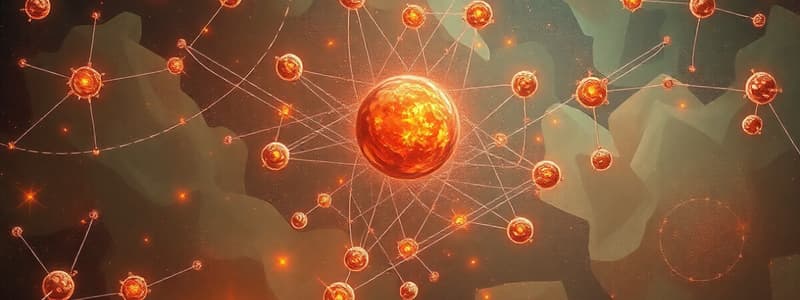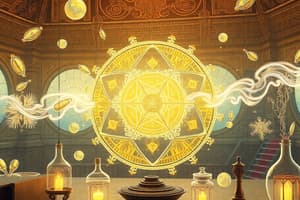Podcast
Questions and Answers
What method did Millikan use to create microscopic oil droplets?
What method did Millikan use to create microscopic oil droplets?
- Electrolysis
- Vaporization
- Atomizer or spray bottle (correct)
- Centrifuge
What fundamental charge did Millikan determine through his experiment?
What fundamental charge did Millikan determine through his experiment?
- 1.6 x 10^-19 C (correct)
- 1.759 x 10^11 C
- 1.602 x 10^-19 C
- 9.107 x 10^-31 C
How did changes in the electric field affect the motion of the oil droplets in Millikan's experiment?
How did changes in the electric field affect the motion of the oil droplets in Millikan's experiment?
- It had no effect on their motion.
- It increased their downward speed only.
- It stabilized their position without change.
- It could reverse their upward movement. (correct)
What type of rays did Goldstein discover in his experiments with cathode-ray tubes?
What type of rays did Goldstein discover in his experiments with cathode-ray tubes?
What did Goldstein conclude these canal rays were composed of?
What did Goldstein conclude these canal rays were composed of?
Who put forth the nuclear model of the atom based on experiments in 1911?
Who put forth the nuclear model of the atom based on experiments in 1911?
What was the charge-to-mass ratio determined by Thomson prior to Millikan's work?
What was the charge-to-mass ratio determined by Thomson prior to Millikan's work?
What calculation did Millikan perform to determine the mass of the electron?
What calculation did Millikan perform to determine the mass of the electron?
What did Chadwick claim about the unknown radiation observed in his experiment?
What did Chadwick claim about the unknown radiation observed in his experiment?
How is the atomic number of an element defined?
How is the atomic number of an element defined?
Which statement about isotopes is correct?
Which statement about isotopes is correct?
What does the mass number (A) of an atom represent?
What does the mass number (A) of an atom represent?
What is the equation used to calculate the mass of an atom (ma)?
What is the equation used to calculate the mass of an atom (ma)?
In a neutral atom, how are the number of protons related to the number of electrons?
In a neutral atom, how are the number of protons related to the number of electrons?
Which of the following statements is true regarding atomic charge?
Which of the following statements is true regarding atomic charge?
How is the mass of a neutron compared to that of an electron?
How is the mass of a neutron compared to that of an electron?
What is the molar mass of Carbon calculated using the natural abundances of its isotopes?
What is the molar mass of Carbon calculated using the natural abundances of its isotopes?
What is the relationship between mass defect and binding energy in a nucleus?
What is the relationship between mass defect and binding energy in a nucleus?
Which of the following equations represents mass-energy equivalence?
Which of the following equations represents mass-energy equivalence?
What is the energy equivalent of 1 electron volt in Joules?
What is the energy equivalent of 1 electron volt in Joules?
How is the charge in Coulombs calculated using current and time?
How is the charge in Coulombs calculated using current and time?
What did William Crookes discover through his discharge tube experiments?
What did William Crookes discover through his discharge tube experiments?
Which characteristic of cathode rays does not support the idea that they consist of particles?
Which characteristic of cathode rays does not support the idea that they consist of particles?
In J.J. Thomson's experiment, what does the measure of e/m refer to?
In J.J. Thomson's experiment, what does the measure of e/m refer to?
What happens when a rotor blade is placed in the path of cathode rays, according to Crookes' findings?
What happens when a rotor blade is placed in the path of cathode rays, according to Crookes' findings?
What conclusion can be drawn from the fact that cathode rays are deflected towards the positive plate in an electric field?
What conclusion can be drawn from the fact that cathode rays are deflected towards the positive plate in an electric field?
What fundamental concept regarding electrons did George Stoney contribute?
What fundamental concept regarding electrons did George Stoney contribute?
Which factor is NOT involved in determining the mass of particles in the equation $m = M * I * t / n * F$?
Which factor is NOT involved in determining the mass of particles in the equation $m = M * I * t / n * F$?
What is the purpose of using low pressure in the Crookes tube?
What is the purpose of using low pressure in the Crookes tube?
What was the major finding from Rutherford's experiment with gold foil and alpha radiation?
What was the major finding from Rutherford's experiment with gold foil and alpha radiation?
What significant concept about atomic structure did Rutherford's model introduce?
What significant concept about atomic structure did Rutherford's model introduce?
What is the mass of a proton based on the content provided?
What is the mass of a proton based on the content provided?
Which particle was discovered by James Chadwick in 1932?
Which particle was discovered by James Chadwick in 1932?
What was the initial hypothesis about the particles produced when Chadwick bombarded beryllium with alpha particles?
What was the initial hypothesis about the particles produced when Chadwick bombarded beryllium with alpha particles?
How do the diameters of atomic nuclei compare to the overall size of an atom?
How do the diameters of atomic nuclei compare to the overall size of an atom?
What role does the lead plate play in the setup of Rutherford's experiment?
What role does the lead plate play in the setup of Rutherford's experiment?
Which statement about alpha particles is accurate based on the content provided?
Which statement about alpha particles is accurate based on the content provided?
What did J.J. Thomson primarily measure to determine the properties of electrons?
What did J.J. Thomson primarily measure to determine the properties of electrons?
What was the key finding regarding the mass-to-charge ratio (e/m) of electrons from Thomson's experiments?
What was the key finding regarding the mass-to-charge ratio (e/m) of electrons from Thomson's experiments?
In Thomson's experiment, what physical force is neglected besides the electric force when analyzing electron motion?
In Thomson's experiment, what physical force is neglected besides the electric force when analyzing electron motion?
What relationship does the equation E = Bv0 demonstrate in Thomson's experiment?
What relationship does the equation E = Bv0 demonstrate in Thomson's experiment?
How is the acceleration of electrons represented in relation to the mass and charge in Thomson's equations?
How is the acceleration of electrons represented in relation to the mass and charge in Thomson's equations?
What was the main outcome of Millikan's oil drop experiment conducted in 1909?
What was the main outcome of Millikan's oil drop experiment conducted in 1909?
What does the symbol |e|/m represent in the context of the content?
What does the symbol |e|/m represent in the context of the content?
Which of the following equations correctly relates the deviation y0 to the mass-to-charge ratio in Thomson's experiment?
Which of the following equations correctly relates the deviation y0 to the mass-to-charge ratio in Thomson's experiment?
Flashcards
Faraday's Constant (F)
Faraday's Constant (F)
The amount of electric charge carried by one mole of electrons. It's a fundamental constant in electrochemistry and is used to relate the amount of charge to the number of electrons transferred in a chemical reaction.
Cathode Rays
Cathode Rays
A stream of electrons emitted from the cathode of a discharge tube. These rays travel in straight lines and can be deflected by electric and magnetic fields.
Crookes Tube Experiment
Crookes Tube Experiment
An experimental setup demonstrating the existence of cathode rays by studying their behaviour in a low-pressure gas discharge tube. This led to the discovery of electrons.
Rectilinear Propagation
Rectilinear Propagation
Signup and view all the flashcards
Electron (e-)
Electron (e-)
Signup and view all the flashcards
J.J. Thomson's Experiment
J.J. Thomson's Experiment
Signup and view all the flashcards
Charge-to-Mass Ratio (e/m)
Charge-to-Mass Ratio (e/m)
Signup and view all the flashcards
Collimating Anodes
Collimating Anodes
Signup and view all the flashcards
Electron Deflection
Electron Deflection
Signup and view all the flashcards
Electric Field (E)
Electric Field (E)
Signup and view all the flashcards
Magnetic Field (B)
Magnetic Field (B)
Signup and view all the flashcards
Millikan's Oil Drop Experiment
Millikan's Oil Drop Experiment
Signup and view all the flashcards
Fundamental Component of Atoms
Fundamental Component of Atoms
Signup and view all the flashcards
What did Millikan's experiment determine?
What did Millikan's experiment determine?
Signup and view all the flashcards
How did Millikan's experiment contribute to our understanding of electrons?
How did Millikan's experiment contribute to our understanding of electrons?
Signup and view all the flashcards
What did Goldstein's experiment discover?
What did Goldstein's experiment discover?
Signup and view all the flashcards
What is the significance of Rutherford's experiment in understanding the atom?
What is the significance of Rutherford's experiment in understanding the atom?
Signup and view all the flashcards
What are canal rays?
What are canal rays?
Signup and view all the flashcards
How did Rutherford's experiment support the nuclear model of the atom?
How did Rutherford's experiment support the nuclear model of the atom?
Signup and view all the flashcards
What is the nucleus of an atom?
What is the nucleus of an atom?
Signup and view all the flashcards
What are nucleons?
What are nucleons?
Signup and view all the flashcards
Rutherford's Gold Foil Experiment
Rutherford's Gold Foil Experiment
Signup and view all the flashcards
Atomic Nucleus
Atomic Nucleus
Signup and view all the flashcards
Proton
Proton
Signup and view all the flashcards
Neutron
Neutron
Signup and view all the flashcards
Alpha Particle
Alpha Particle
Signup and view all the flashcards
Atomic Size vs. Nuclear Size
Atomic Size vs. Nuclear Size
Signup and view all the flashcards
Chadwick's Experiment
Chadwick's Experiment
Signup and view all the flashcards
Neutron Properties
Neutron Properties
Signup and view all the flashcards
Average Molar Mass
Average Molar Mass
Signup and view all the flashcards
Mass Defect (∆m)
Mass Defect (∆m)
Signup and view all the flashcards
Binding Energy
Binding Energy
Signup and view all the flashcards
Einstein's Mass-Energy Equivalence
Einstein's Mass-Energy Equivalence
Signup and view all the flashcards
Electron Volt (eV)
Electron Volt (eV)
Signup and view all the flashcards
What is a neutron?
What is a neutron?
Signup and view all the flashcards
What is the mass of a neutron?
What is the mass of a neutron?
Signup and view all the flashcards
What is the atomic number (Z)?
What is the atomic number (Z)?
Signup and view all the flashcards
What is the mass number (A)?
What is the mass number (A)?
Signup and view all the flashcards
What are isotopes?
What are isotopes?
Signup and view all the flashcards
What is relative abundance of isotopes?
What is relative abundance of isotopes?
Signup and view all the flashcards
How are isotopes separated?
How are isotopes separated?
Signup and view all the flashcards
Study Notes
Introduction to Matter
- Democritus proposed that all matter is composed of indivisible particles called "atomos" in the fifth century B.C.
- John Dalton formulated a precise definition of atoms in 1808, stating that all matter is composed of small particles called atoms.
Composition of Atoms
- Atoms are not the smallest particles, but are made of subatomic particles.
- Subatomic particles, including electrons, protons, and neutrons were discovered in the late 1800s to early 1900s.
Discovery of Electrons
- Faraday's laws of electrolysis highlighted a relationship between matter and electricity.
- Faraday's laws demonstrated that chemical reactions occur when electricity is passed through an electrolyte, liberating matter at the electrodes.
- Crookes' experiments with cathode rays showed the existence of negatively charged particles (electrons) that travel from the cathode to the anode.
Characteristics of Electrons
- J.J. Thomson's experiments measured the charge-to-mass ratio of electrons (e/m).
- This ratio was consistent regardless of the cathode material or gas used, suggesting electrons are a fundamental component of all atoms.
Electron Charge
- Robert Millikan's oil-drop experiment determined the fundamental charge of an electron.
- Millikan's experiment successfully determined the charge of an electron.
- The charge-to-mass ratio of electrons and the fundamental electron charge, enabled scientists to calculate the electron mass.
Nucleus and Nucleons
- Goldstein's discovery of canal rays provided evidence for positively charged particles (protons) inside atoms.
- Rutherford's gold foil experiment demonstrated the nuclear model of the atom, showing that most of the atom's mass is concentrated in a small, dense nucleus.
- Chadwick's experiment discovered neutrons, neutral subatomic particles with a mass similar to protons.
Nucleons and Atomic Structure
- Protons and neutrons residing within atomic nuclei are called nucleons.
- The atomic number (Z) represents the number of protons in an atom.
- The mass number (A) represents the total number of protons and neutrons in an atom.
- Atoms with the same number of protons but different numbers of neutrons are isotopes.
Atomic Mass
- The mass of an atom (ma) is primarily determined by the total mass of its protons and neutrons (nucleons).
- Atomic mass is approximately equal to the mass number (A).
Isotopes
- Atoms with the same atomic number but different mass numbers are called isotopes.
- Isotopes have similar chemical properties.
- Isotopes can be separated based on their differences in mass.
Binding Energy
- The mass of the nucleus is less than the mass of its constituent protons and neutrons.
- This difference, called the mass defect, is converted into the binding energy of the nucleus.
- Binding energy is the energy required to break the nucleus into its constituent protons and neutrons.
Studying That Suits You
Use AI to generate personalized quizzes and flashcards to suit your learning preferences.




